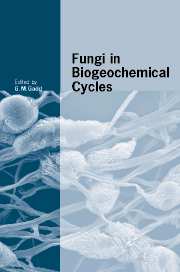Book contents
- Frontmatter
- Contents
- List of Contributors
- Preface
- 1 Geomicrobiology: relative roles of bacteria and fungi as geomicrobial agents
- 2 Integrated nutrient cycles in boreal forest ecosystems – the role of mycorrhizal fungi
- 3 Fungal roles in transport processes in soils
- 4 Water dynamics of mycorrhizas in arid soils
- 5 Integrating ectomycorrhizal fungi into quantitative frameworks of forest carbon and nitrogen cycling
- 6 Role of arbuscular mycorrhizal fungi in carbon and nutrient cycling in grassland
- 7 The role of wood decay fungi in the carbon and nitrogen dynamics of the forest floor
- 8 Relative roles of bacteria and fungi in polycyclic aromatic hydrocarbon biodegradation and bioremediation of contaminated soils
- 9 Biodegradation and biodeterioration of man-made polymeric materials
- 10 Fungal dissolution and transformation of minerals: significance for nutrient and metal mobility
- 11 Fungal activities in subaerial rock-inhabiting microbial communities
- 12 The oxalate–carbonate pathway in soil carbon storage: the role of fungi and oxalotrophic bacteria
- 13 Mineral tunnelling by fungi
- 14 Mineral dissolution by ectomycorrhizal fungi
- 15 Lichen biogeochemistry
- 16 Fungi in subterranean environments
- 17 The role of fungi in carbon and nitrogen cycles in freshwater ecosystems
- 18 Biogeochemical roles of fungi in marine and estuarine habitats
- Index
- References
4 - Water dynamics of mycorrhizas in arid soils
Published online by Cambridge University Press: 10 December 2009
- Frontmatter
- Contents
- List of Contributors
- Preface
- 1 Geomicrobiology: relative roles of bacteria and fungi as geomicrobial agents
- 2 Integrated nutrient cycles in boreal forest ecosystems – the role of mycorrhizal fungi
- 3 Fungal roles in transport processes in soils
- 4 Water dynamics of mycorrhizas in arid soils
- 5 Integrating ectomycorrhizal fungi into quantitative frameworks of forest carbon and nitrogen cycling
- 6 Role of arbuscular mycorrhizal fungi in carbon and nutrient cycling in grassland
- 7 The role of wood decay fungi in the carbon and nitrogen dynamics of the forest floor
- 8 Relative roles of bacteria and fungi in polycyclic aromatic hydrocarbon biodegradation and bioremediation of contaminated soils
- 9 Biodegradation and biodeterioration of man-made polymeric materials
- 10 Fungal dissolution and transformation of minerals: significance for nutrient and metal mobility
- 11 Fungal activities in subaerial rock-inhabiting microbial communities
- 12 The oxalate–carbonate pathway in soil carbon storage: the role of fungi and oxalotrophic bacteria
- 13 Mineral tunnelling by fungi
- 14 Mineral dissolution by ectomycorrhizal fungi
- 15 Lichen biogeochemistry
- 16 Fungi in subterranean environments
- 17 The role of fungi in carbon and nitrogen cycles in freshwater ecosystems
- 18 Biogeochemical roles of fungi in marine and estuarine habitats
- Index
- References
Summary
Introduction
The interaction of mycorrhizas and water in understanding plant water dynamics has been relevant since Frank (1885) first coined the term mykorhiza, a plant–fungus mutualism. He described an ectomycorrhiza as a ‘wet-nurse’ to the host in that water and nutrients must flow through the hyphae to the plant root tip. Stahl (1900) proposed that mycorrhizas increased water throughput, depositing greater amounts of nutrients in the roots resulting in the improved growth. We now know that carbon and nutrient exchange is an active process, regulated by both plant and fungal genes, and requiring substantial inputs of energy from the host and concentrating mechanisms in the fungus. However, water movement is a passive process. That is, it flows in response to energy gradients, without regard to active processes. Because it is a passive process, in mesic regions a large amount of water flows through a relatively saturated soil around the fungal hypha into the rather high area of root surface. This occurs at rates which would not be affected by the comparatively small surface area of the hypha–root interface. The focus of studies on mycorrhizas and water relations has been on whether mycorrhizas enhance plant water uptake with drought. This becomes rather critical in that past studies have often misinterpreted data of mycorrhizas and water flux, or designed studies measuring water fluxes in materials such as sand, or in limited potting volumes (relative to root length) that place unreasonable constraints on mycorrhizal response.
- Type
- Chapter
- Information
- Fungi in Biogeochemical Cycles , pp. 74 - 97Publisher: Cambridge University PressPrint publication year: 2006
References
- 17
- Cited by



